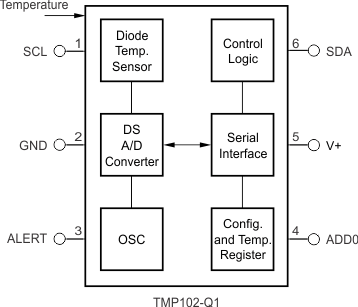SBOS702E October 2014 – September 2021 TMP102-Q1
PRODUCTION DATA
- 1 Features
- 2 Applications
- 3 Description
- 4 Revision History
- 5 Pin Configuration and Functions
- 6 Specifications
-
7 Detailed Description
- 7.1 Overview
- 7.2 Functional Block Diagram
- 7.3
Feature Description
- 7.3.1 Digital Temperature Output
- 7.3.2 Serial Interface
- 7.3.3 Bus Overview
- 7.3.4 Serial Bus Address
- 7.3.5 Writing and Reading Operation
- 7.3.6 Slave Mode Operations
- 7.3.7 SMBus Alert Function
- 7.3.8 General Call
- 7.3.9 High-Speed (Hs) Mode
- 7.3.10 Time-Out Function
- 7.3.11 Timing Diagrams
- 7.3.12 Two-Wire Timing Diagrams
- 7.4 Device Functional Modes
- 7.5 Programming
- 8 Application and Implementation
- 9 Power Supply Recommendations
- 10Layout
- 11Device and Documentation Support
- 12Mechanical, Packaging, and Orderable Information
Package Options
Mechanical Data (Package|Pins)
- DRL|6
Thermal pad, mechanical data (Package|Pins)
Orderable Information
3 Description
The TMP102-Q1 device is a digital temperature sensor ideal for NTC and PTC thermistor replacement where high accuracy is required. The device offers an accuracy of ±0.5°C without requiring calibration or external component signal conditioning. Device temperature sensors are highly linear and do not require complex calculations or lookup tables to derive the temperature. The on-chip 12-bit ADC offers resolutions down to 0.0625°C.
The 1.6-mm × 1.6-mm SOT563 package is 68% smaller footprint than an SOT23 package. The TMP102-Q1 device features SMBus, two-wire, and I2C interface compatibility, and allows up to four devices on one bus. The device also features an SMBus alert function. The device is specified to operate over supply voltages from 1.4 V to 3.6 V with the maximum quiescent current of 10 µA over the full operating range.
The TMP102-Q1 device is designed for extended temperature measurement in a variety of communication, computer, consumer, environmental, industrial, and instrumentation applications. The device is specified for operation over a temperature range of –40°C to 125°C.
The TMP102-Q1 production units are 100% tested against sensors that are NIST-traceable and are verified with equipment that are NIST-traceable through ISO/IEC 17025 accredited calibrations.
| PART NUMBER | PACKAGE | BODY SIZE (NOM) |
|---|---|---|
| TMP102-Q1 | SOT563 (6) | 1.60 mm × 1.20 mm |
 Block Diagram
Block Diagram